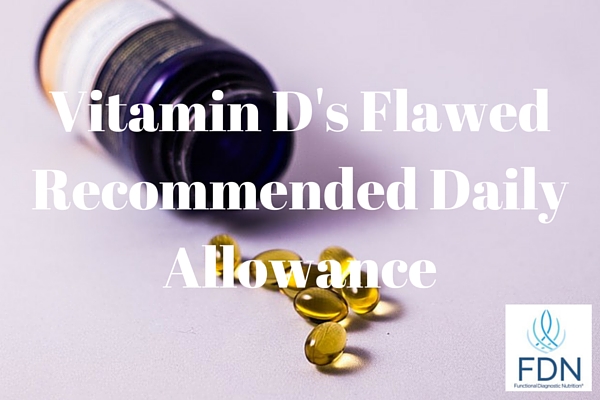While it’s great that the FDA requires supplement and food labels to contain percentages of daily recommended values, these numbers can often be misleading. Vitamin D is one of the most important substances in regard to supporting good health and also happens to have one of the most misleading Recommended Daily Allowances.
If you look at the label on the back of food or supplement packaging, you’ll see a list of nutrients that specifies the amount of each nutrient contained in a single serving of the product and what percentage of the recommended Daily Value that this amount represents. The FDA requires food and supplement manufacturers to include this information on the labels of their products to help you determine how much of your daily recommended allowance you’re consuming.
What Exactly is the Daily Value?
The Daily Value is the recommended daily intake of a particular nutrient and is generalized based on a 2,000 calorie diet. For vitamins and minerals, the Daily Value is based on a standard called the Reference Daily Intake, which is based on an older and more familiar standard called the Recommended Daily Allowance, or RDA. The RDA was originally developed by the National Academy of Sciences and is intended to represent the amount of a nutrient that should be consumed on a daily basis to avoid deficiency and any of the health conditions that would be likely to follow.
Are Daily Values Important?
The one thing that’s certain about Daily Values is that their derivation can be quite confusing! However, for someone who eats a well rounded diet based on natural whole foods such as meat, fish, fruit, and vegetables, Daily Values are less important because such a diet provides plenty of the nutrients needed to support good health. While Daily Values are much more useful for people who use a lot of supplements, they can also be very misleading.
Why Daily Values are a Flawed Standard
The primary shortcoming of Daily Values is that they’re based on RDAs. In many cases, the RDA is nothing more than the minimum amount of a nutrient needed to prevent a particular condition that’s caused by a deficiency of the same nutrient. This is misleading because the amount of a nutrient needed to prevent a disorder can be significantly lower than the amount needed to support optimal function and health.
The Misleading RDA for Vitamin D
Robert Heaney MD, a prominent vitamin D researcher, served as a member of the Food and Nutrition Board over a decade ago to help establish the RDA for vitamin D. According to Heaney, the resulting RDA of 200 IU for vitamin D was based on how much of it is needed to prevent rickets. This is troubling because vitamin D deficiency can still cause significant problems at levels that aren’t extreme enough to cause rickets. To this day, the RDA for vitamin D is still 200 IU for all people 50 years old or younger. Although it increases to 400 IU for people older than 50 and to 600 IU for people over 70, these values are still quite low.
The research used to determine vitamin D’s RDA indicates that blood levels of vitamin D in a “healthy individual” range from 20 nmol/liter to 37.5 nmol/liter. However, this range only represents the typical vitamin D level for an average person, and by today’s standards, the average person is far from being a shining image of excellent health. In fact, many experts believe that as much as 80% of the population is deficient in vitamin D. Research suggests that someone who receives adequate sun exposure will have vitamin D levels in the range of 40 nmol/liter to 60 nmol/liter. As such, the “healthy” vitamin D range that the RDA is based on would be considered by many to be deficient.
In contrast to the 200 IU RDA for vitamin D, research is showing that people who don’t receive regular sun exposure would benefit from anywhere between 1,000 IU and 5,000 IU of vitamin D3 supplementation per day. In some cases where deficiency is present, the recommendations are even higher! Although this may sound like an extreme amount of vitamin D, 1,000 IU is only 25 micrograms or 0.025 milligrams. For more information about recent research on vitamin D requirements, visit the Vitamin D Council.
What Does This Mean?
Despite the fact that many experts consider the RDA of vitamin D to be far too low, which has been the case for other RDA values as well, this is by no means justification to completely ignore RDA values and consume however much of a supplement you wish to. More than anything, it’s just another indication that you need to take responsibility and educate yourself so that you can make informed decisions about your health.







